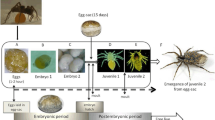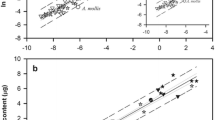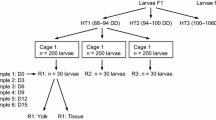Abstract
Energy metabolism during embryonic development of snakes differs in several respects from the patterns displayed by other reptiles. There are, however, no previous reports describing the main energy source for development, the yolk lipids, in snake eggs. There is also no information on the distribution of yolk fatty acids to the tissues during snake development. In eggs of the water python (Liasis fuscus), we report that triacylglycerol, phospholipid, cholesteryl ester and free cholesterol, respectively, form 70.3%, 14.1%, 5.7% and 2.1% of the total lipid. The main polyunsaturate of the yolk lipid classes is 18:2n-6. The yolk phospholipid contains 20:4n-6 and 22:6n-3 at 13.0% and 3.6% (w/w), respectively. Approximately 10% and 30% of the initial egg lipids are respectively recovered in the residual yolk and the fat body of the hatchling. A major function of yolk lipid is, therefore, to provision the neonate with large energy reserves. The proportion of 22:6n-3 in brain phospholipid of the hatchling is 11.1% (w/w): this represents only 0.24% of the amount of 22:6n-3 originally present in the egg. This also contrasts with values for free-living avian species where the proportion of DHA in neonatal brain phospholipid is 16–19%. In the liver of the newly hatched python, triacylglycerol, phospholipid and cholesteryl ester, respectively, form 68.2%, 7.7% and 14.3% of total lipid. This contrasts with embryos of birds where cholesteryl ester forms up to 80% of total liver lipid and suggests that the mechanism of lipid transfer in the water python embryo differs in some respects from the avian situation.
Similar content being viewed by others
Abbreviations
- ARA :
-
arachidonic acid
- DHA :
-
docosahexaenoic acid
References
Barton NWH, Fox NC, Surai PF, Speake BK (2002) Vitamins E and A, carotenoids, and fatty acids of the raptor egg yolk. J Raptor Res 36:33–38
Bedford G, Christian KA (2001) Metabolic response to feeding and fasting in the water python (Liasis fuscus). Aust J Zool 49:379–387
Decrock F, Groscolas R, McCartney RJ, Speake BK (2001) Transfer of n-3 and n-6 polyunsaturated fatty acids from yolk to embryo during development of the king penguin. Am J Physiol 280:R843–R853
Decrock F, Groscolas R, Speake BK (2002) FA composition of heart and skeletal muscle during embryonic development of the king penguin. Lipids 37:407–415
Farkas K, Ratchford IAJ, Noble RC, Speake BK (1996) Changes in the size and docosahexaenoic acid content of adipocytes during chick embryo development. Lipids 31:313–321
Hohl CM, Rosen P (1987) The role of arachidonic acid in rat heart cell metabolism. Biochim Biophys Acta 921:356–363
Jones SM, Bennett EJ, Swadling KM (1998) Lipids in yolks and neonates of the viviparous lizard Niveoscincus metallicus. Comp Biochem Physiol B 121:465–470
Madsen T, Shine R (1996a) Determinants of reproductive output in female water pythons (Liasis fuscus: Pythonidae). Herpetologica 52:146–159
Madsen T, Shine R (1996b) Seasonal migration of predators and prey—a study of pythons and rats in tropical Australia. Ecology 77:149–156
Madsen T, Shine R (1998) Quantity or quality? Determinant of maternal reproductive success in tropical pythons (Liasis fuscus). Proc Roy Soc Lond B 265:1521–1525
Madsen T, Shine R (2000) Silver spoon and snake body sizes: prey availability early in life influences long-term growth rates of free-ranging pythons. J Anim Ecol 69:952–958
Maldjian A, Farkas K, Noble RC, Cocchi M, Speake BK (1995) The transfer of docosahexaenoic acid from the yolk to the tissues of the chick embryo. Biochim Biophys Acta 1258:81–89
Maldjian A, Cristofori C, Noble RC, Speake BK (1996) The fatty acid composition of brain phospholipids from chicken and duck embryos. Comp Biochem Physiol B 115:153–158
Noble RC, Deeming DC, Ferguson MWJ, McCartney R (1990) Changes in the lipid and fatty acid composition of the yolk during embryonic development of the alligator (Alligator mississippiensis). Comp Biochem Physiol B 96:183–187
Packard GC, Packard MJ, Miller K, Boardman TJ (1988) Effects of temperature and moisture during incubation on carcass composition of hatchling snapping turtles (Chelydra serpentina). J Comp Physiol B 158:117–125
Ross RA, Marzec G (1990) The reproductive husbandry of pythons and boas. Institute for Herpetological Research, Stanford CA
Rowe JW, Holy L, Ballinger RE, Stanley-Samuelson D (1995) Lipid provisioning of turtle eggs and hatchlings: total lipid, phospholipid, triacylglycerol and triacylglycerol fatty acids. Comp Biochem Physiol B 112:323–330
Salem N Jr, Litman B, Kim H-Y, Gawrisch K (2001) Mechanisms of action of docosahexaenoic acid in the nervous system. Lipids 36:945–959
Shine R, Madsen T (1997) Prey abundance and predator reproduction: rats and pythons on a tropical Australian floodplain. Ecology 78:1078–1086
Speake BK, Surai PF (2000) Wild birds and their brains. Avian Poult Biol Rev 11:308
Speake BK, Thompson MB (1999) Comparative aspects of yolk lipid utilisation in birds and reptiles. Poult Avian Biol Rev 10:181–211
Speake BK, Thompson MB (2000) Lipids of the eggs and neonates of oviparous and viviparous lizards. Comp Biochem Physiol A 127:453–467
Speake BK, Noble RC, McCartney RJ, Ferguson MWJ (1994) Differences in tissue-specific lipid composition between embryos of wild and captive-breeding alligators (Alligator mississippiensis). J Zool (Lond) 234:565–576
Speake BK, Murray AMB, Noble RC (1998) Transport and transformations of yolk lipids during development of the avian embryo. Prog Lipid Res 37:1-32
Speake BK, Surai PF, Noble RC, Beer JV, Wood NAR (1999) Differences in egg lipid and antioxidant composition between wild and captive pheasants and geese. Comp Biochem Physiol B 124:101–107
Speake BK, Surai PF, Bortolotti GR (2002) Fatty acid profiles of yolk lipids of five species of wild ducks (Anatidae) differing in dietary preference. J Zool (Lond) 257:533–538
Surai PF, Speake BK, Bortolotti GR, Negro JJ (2001) Captivity diets alter egg yolk lipids of a bird of prey (the American kestrel) and of a galliforme (the red-legged partridge). Physiol Biochem Zool 74:153–160
Swain R, Jones SM (2000) Facultative placentrophy: half-way house or strategic solution. Comp Biochem Physiol A 127:441–451
Thompson MB, Speake BK (2003) Energy and nutrient utilisation by embryonic reptiles. Comp Biochem Physiol A 133:529–538
Thompson MB, Speake BK, Russell KJ, McCartney RJ, Surai PF (1999) Changes in the fatty acid profiles and in protein, ion and energy contents of eggs of the Murray short-necked turtle, Emydura macquarii (Chelonia, Pleurodira) during development. Comp Biochem Physiol A 122:75–84
Thompson MB, Speake BK, Russell KJ, McCartney RJ (2001a) Utilisation of lipids, protein, ions and energy during embryonic development of Australian oviparous skinks in the genus Lampropholis. Comp Biochem Physiol A 129:313–326
Thompson MB, Speake, BK, Russell KJ, McCartney RJ (2001b) Nutrient uptake by embryos of the Australian viviparous lizard Eulamprus tympanum. Physiol Biochem Zool 74:560–567
Thompson MB, Stewart JR, Speake BK, Russell KJ, McCartney RJ (2001c) Utilisation of nutrients by embryos of the enigmatic Australian viviparous skink Niveoscincus coventryi. J Exp Zool 290:291–298
Vajda K, Ferguson MWJ, Shand JH, Noble RC, Speake BK (1999) Activities of acyl-CoA:cholesterol acyltransferase and cholesteryl ester hydrolase in the yolk sac membrane of the alligator (Alligator mississippiensis) embryo. Comp Biochem Physiol B 122:301–307
Acknowledgements
This work was supported by an Australian Research Council Large Grant (to MBT) and by the Scottish Executive Rural Affairs Department (to BKS). Animals were collected and sent to Sydney under permits from the Conservation Commission of the Northern Territory and New South Wales National Parks and Wildlife Service. Research was conducted with approval from the University of Sydney Animal Ethics Committee. We thank M. Louden and P. Harvey for help with maintaining the gravid snakes prior to oviposition.
Author information
Authors and Affiliations
Corresponding author
Additional information
Communicated by G. Heldmaier
Rights and permissions
About this article
Cite this article
Speake, B.K., Thompson, M.B., Thacker, F.E. et al. Distribution of lipids from the yolk to the tissues during development of the water python (Liasis fuscus). J Comp Physiol B 173, 541–547 (2003). https://doi.org/10.1007/s00360-003-0362-8
Accepted:
Published:
Issue Date:
DOI: https://doi.org/10.1007/s00360-003-0362-8




